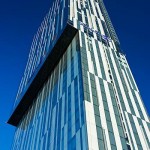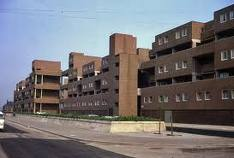–
09/11/2024
NEXT TOUR
Okay, that was written in the 1850s, but for 19th century grandeur Manchester is hard to beat. There are Classical meeting halls and clubs, Italianate cotton palaces, Gothic towers and spires, and Baroque banks – and all of it is stolen, stolen from grand European creations which hopeful architects had sketched on their Grand Tour and then reproduced across the city.
The Gran Guardia Vecchia in Verona provided Edward Walters with a model for the Free Trade Hall; the St Mark’s Campanile in Venice was adapted by Thomas Worthington for the Police Courts on Minshull Street; Ypres Cloth Hall became Manchester Town Hall.
Read on, for the 20th century and beyond...
In the 20th century the new architects adopted a similar approach, but this time it was the gleaming skyscrapers of Chicago and New York that enthused them. However those in charge of Manchester refused to let progressive architects such as Harry S. Fairhurst and Joe Sunlight fill the skyline with granite and glass, and so Manchester missed out on one of the most exciting periods in building history. Restrictions on height eased after the Second World War but Manchester was nervous of reaching for the stars until recently, and it is true to say our towers are poor cousins of the glories that Adrian Smith, Chris Wilkinson and Renzo Piano have been creating across the globe.
We examine the city’s building legacy as we twist in and out of the city centre streets, straining our necks for a glimpse of a glorious Gaudi-like gable, a Venetian vista, a Greek giant order or a stroke of sacred geometry.
***
Want to read more?
Here’s the piece New Manchester Walks’ Ed Glinert wrote for the Manchester International Festival 2011 brochure.
The best view of Manchester’s architecture is from Salford. Stand on isolated, lonely Oldfield Road, off Salford Crescent, by the dried up route of the Manchester, Bolton and Bury Canal, and look west, and there it is: Manchester, caught in a perspective of triumphant towers and soaring skyscrapers. Marvel at the sticking-out “drawers” of the Civil Justice Centre aside its formidable aluminium composite bulk and suspended glass wall, the largest in Europe. Look in awe at the Art Deco fortress of Sunlight House, and take in an intoxicating vision of the Beetham, the subtlety of its shape now suitably sensed when removed by the long gap.
Walk from here into Manchester and the finer detailing of these facades becomes sharper. Central Manchester is dominated by 19th century architects’ desperation to re-create the traditional styles of Europe – Greek, Gothic, Italianate, Baroque – on uncharted territory. Manchester has few original buildings, just brilliant copies. The Memorial Hall on the corner of Albert Square and Southmill Street by Thomas Worthington is pure 15th century Venice. What’s left of the Free Trade Hall on nearby Peter Street is Edward Walters’ take on the Gran Guardia Vecchia in Verona. You want more Italy on the streets of Manchester? Head for the Athenaeum on Princess Street, now part of the art gallery, and behold a Florentine Palace that’s pure Palazzo Pandolfini by Raphael, while inside ironically is a large collection of Pre-Raphaelite paintings himself.
On the way, you might head past Friends Meeting House on Mount Street. It’s Greek. Ancient Greek. The façade is based on the Temple on the Ilissus because Richard Lane, designing in the 1820s, believed that as Manchester had no cultural legacy the city should pay homage to the territory where modern ideas of aesthetics, art and architecture were shaped. Not that everybody was impressed with the slew of Classical revival buildings he created. The Builder magazine for instance derided his work (Chorlton-on-Medlock Town Hall, St Thomas’s Pendleton) as looking like a factories with the front of temples stuck on.
At least in modern times Manchester has begun to originate. The Bruntwood-owned Bank Chambers/Bank House on Faulkner Street, between Piccadilly Gardens and Chinatown, is a magnificent segue of big tower and little tower on a concrete podium. It was designed by Fitzroy, Robinson in 1971 and appropriately is home to Fairhurst’s, the most prolific architects in Manchester history. Pity it will need another hundred years before its brutalist beauty and granite-and-glass glamour are fully appreciated.



